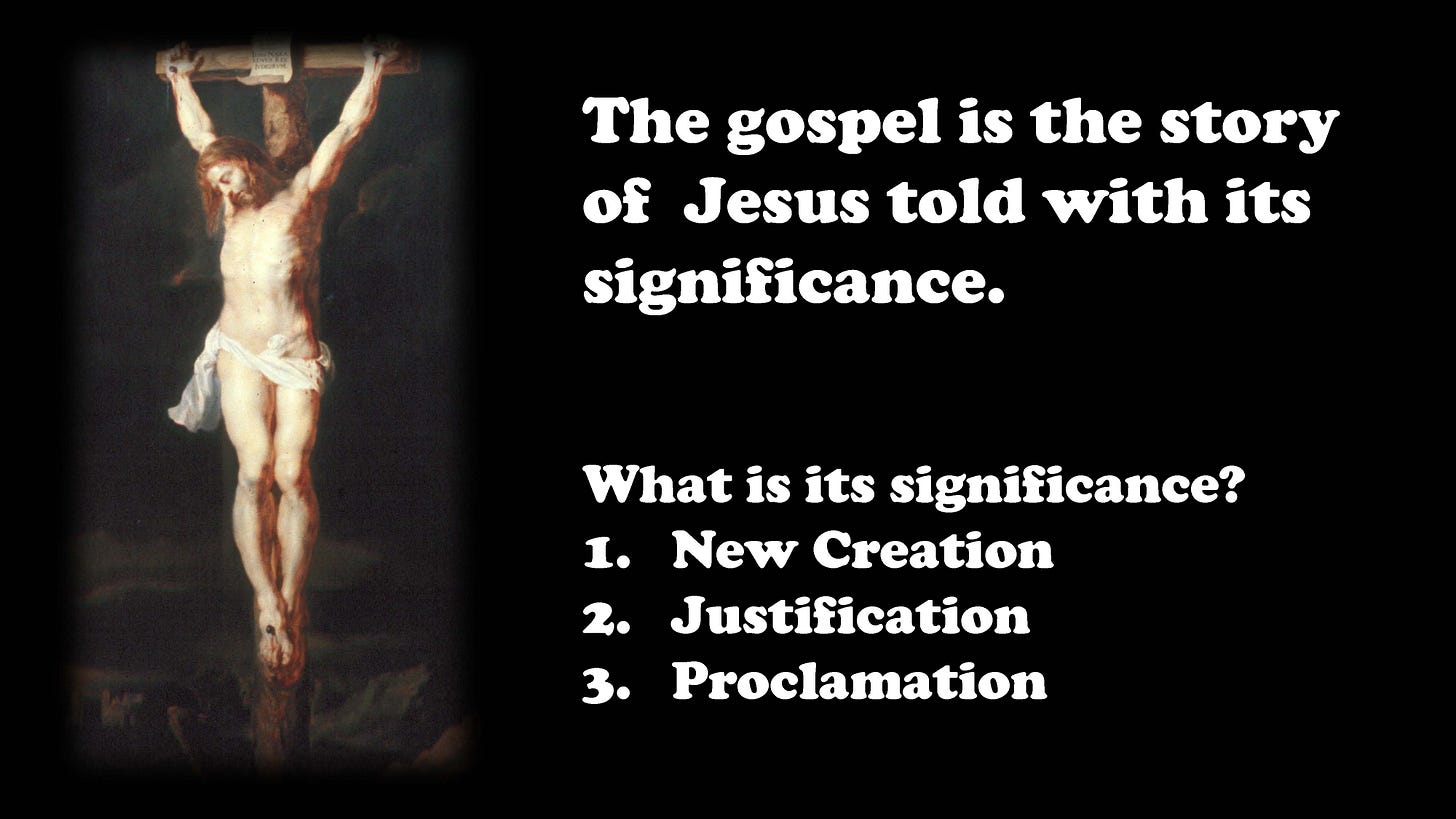The story of Jesus and its significance come in a single package. The significance is built into the story itself. The theologian simply unpacks that significance usually in three or more ways. Theologically, the significance of story of Jesus is grasped in terms of new creation, justification, and proclamation. In this post our topic is proclamation.
The Gospel as Proclamation
I have been saying that the gospel is the report of divine grace that establishes justification and opens the door to new creation. But it is more than a report, much more. The very telling of the gospel participates in the reality of the gospel itself. The gospel is news, and as such presses to be told and retold. The gospel when preached is not merely information or even revelation about justice. Rather, the very preaching itself makes that divine justice a possibility for the hearer. The proclamation of the news itself bears the power of salvation.
A former cardinal and former pope, Benedict XVI, designates the gospel’s proclamation a “performative” utterance. “The evangelium, the Gospel, is not just informative speech, but performative speech—not just the imparting of information, but action, efficacious power that enters into the world to save and transform” (Pope, 2007, p. 47). What we need to add to the performative dimension is the mystical dimension. The Holy Spirit is effectively present within the proclamation.
Because the power of the gospel is borne by preaching, it has an ambiguous relationship to written scripture and tradition. On the one hand, Paul denies any dependency upon the apostolic tradition that preceded him. “I did not confer with any human being,” he declares in Galatians 1:16. He received the gospel from direct revelation, from his vision of the resurrected one on the road to Damascus and perhaps an ecstatic experience in the desert of Arabia. Paul does not need to appeal to the authority of the original apostles because the gospel is not simply a bundle of teachings or traditions that can be memorized and transmitted. It is not a finished depositum fidei or timeless dogma. It is itself the manifesting of the Spirit in the world. Hence, it is something that lives.
On the other hand, Paul occasionally talks about the gospel as a tradition (παράδоσιϛ) or teaching (διδαχή) that can be handed down and that needs to be preserved. In Paul’s preaching he passes on what he has received (1 Cor. 15:1-4).
What had he received? Most probably a version of the Jesus story told by Christians in Antioch. This he passes on to the Corinthians and others. Nevertheless, his radical appropriation and reinterpretation of such things as the Jewish law in the doctrine of justification show a creative appropriation of what he received. Paul does more than merely repeat what he has heard. Even the “ancestral traditions” (Gal. 1:14) come to life in a new way for Paul when they help bear the gospel, when they become part of the nascent new tradition.
Thus, a gospel-oriented tradition is being born in the era of Paul. The gospel has a flexible content that can be passed on through teaching. Be that as it may, the content of the gospel comes to life only through its proclamation. Tradition clearly stands in the service of preaching, not vice versa. There is something elusive and alive about the gospel that makes it subject to tradition, yes, but always something more than tradition.
The idea of the spoken word—the Word of God—is key to understanding the living tradition of the gospel. The whole life and destiny of Jesus are in their unique way God’s word spoken to the world. Jesus Christ is the living word, the viva vox. This makes telling the story of Jesus divine address.
So for the church to present the gospel through preaching or teaching is to participate in the very activity whereby God addresses the world. Through our re-presenting the originary symbols of the gospel experience as reported to us in the New Testament, God actually calls people to live in the light of the revelatory action. Telling and listening to the story of Jesus with its significance are themselves part of the ongoing work of God.
Word and World
Preparation of the sermon begins when the preacher prays to the Holy Spirit for guidance in gospel proclamation. Specifically, the preacher prays that what gets heard is not just the preacher’s own opinions or some chuckle-worthy anecdotes , but rather the very Word of God. If it’s genuinely the Word of God, it creates within the listener something new and transformative. The preacher’s many human words are but transparent symbols through which the one Word of God speaks to the listening heart.
Sermon preparation includes in the preacher’s mind a dialectic between Word and World. Just as God’s Word (logos) became incarnate in Jesus of Nazareth, today’s preacher yearns to see God’s Word become incarnate in today’s world. “The Word needs to invade us with power and critique, meeting us where we are but leading us in wonder to something new,” writes pastor and clinical psychologist Timothy Weber. “The encounter between the Word and the World is the deep current flowing through preaching” (Weber 2025, Kindle 22).
Conclusion
We Christians deem the gospel to be the truth. When we tell the story of Jesus with its significance, we are proclaiming what has been revealed to us about God in the cross and resurrection. Ultimate reality has spoken. The gospel tells us what ultimate reality has said, albeit in historically conditioned symbols.
More. In the very proclamation of the gospel, the Holy Spirit is present to invite the listener into new life.
In summary, I have been saying that the material norm for all Christian thinking and theology is the gospel. Where do we go to learn the gospel? To the Bible, of course. But as the Word of God, the story of Jesus told in the Bible is itself a living Word that effects new creation, justification, and proclamation.
Substack ST 2034 What is the gospel? Part Four
Patheos ST 2004 What is the gospel?
Patheos ST 2005 What is Justification by Faith?
Patheos ST 2026 Faith alone belongs to the gospel. And Luther was right!
Substack ST 2031 What is the gospel? Part One
Substack ST 2032 What is the gospel? Part Two
Substack ST 2033 What is the gospel? Part Three
Substack ST 2034 What is the gospel? Part Four
▓
Ted Peters is a Lutheran pastor and emeritus seminary professor, teaching theology and ethics. He is author of Short Prayers and The Cosmic Self. His one volume systematic theology is now in its 3rd edition, God—The World’s Future (Fortress 2015). His book, God in Cosmic History, traces the rise of the Axial religions 2500 years ago. He has undertaken a thorough examination of the sin-and-grace dialectic in two works, Sin: Radical Evil in Soul and Society (Eerdmans 1994) and Sin Boldly! (Fortress 2015). See his collection of essays, The Voice of Public Theology (ATF 2023). Click on Ted’s website: TedsTimelyTake.com.
▓
Works Cited
Balch, D. (2015). Contested Ethnicities and Images. Tubingen: Mohr Siebeck.
Barth, K. (1936-1962). Church Dogmatics, 4 Volumes. Edinburgh: T&T Clark.
Bayer, O. (2007). With Luther in the Present. Lutheran Quarterly 21:1, 1-19.
Jeremias, J. (1965). The Central Message of the New Testament. New York: Scribners.
Luther, M. (2015-2020). The Freedom of a Christian. In M. Luther, The Annotated Luther, 5 Volumes (pp. 1: 467-518). Minneapolis MN: Fortress Press.
Pannenberg, W. (1991-1998). Systematic Theology, 3 Volumes. Grand Rapids MI: Wm B Eerdmans.
Peters, T. (2015). God--The World's Future: Systematic Theology for a New Era (3rd ed.). Minneapolis MN: Fortress Press.
Pope, B. X. (2007). Jesus of Nazareth. New York: Doubleday.
Weber, Timothy (2025). Making All Things New, Volume 1. Kindle.
Wright, N. T. (2015). Simply Good News. New York: Harper.







